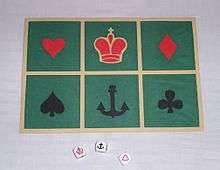Crown and Anchor

Crown and Anchor is a simple dice game, traditionally played for gambling purposes by sailors in the Royal Navy as well as those in the British merchant and fishing fleets.
History
The game originated in the 18th century. It is still popular in the Channel Islands and Bermuda, but is strictly controlled and may be played legally only on certain occasions, such as the Channel Islands' three annual agricultural shows, or Bermuda's annual Cup Match cricket game.
Three special dice are used in Crown and Anchor. The dice are equal in size and shape to standard dice, but instead of one through six pips, they are marked with six symbols: crown, anchor, diamond, spade, club and heart. (The last four are the same symbols used on playing cards.)
Rules of play

The game is played between a player and a banker. A canvas or felt mat marked with the six symbols is used for play. The player places bets on one or more symbols. He then throws the three dice. If there is a bet on any symbol which comes up on one or more of the dice, in addition to returning the stake the banker pays the player the amount of his stake for each die showing that symbol: even money if one, 2:1 if two, and 3:1 if three. If the symbol doesn't come up, the player loses his bet.
The expected return of a $1 wager on a particular symbol is calculated as follows:
- The chance of the symbol coming up on none of the dice is 5/6 × 5/6 × 5/6, which is 125/216. The player loses $1 in this case.
- The chance of the symbol coming up on all three dice is 1/6 × 1/6 × 1/6, which is 1/216. The player wins back the $1 plus $3 more.
- The chance of the symbol coming up on two of three dice is C(3,1) x 1/6 × 1/6 × 5/6, which is 15/216. The player wins back the $1 plus $2 more.
- The chance of the symbol coming up on one of three dice is C(3,1) × 1/6 × 5/6 × 5/6, which is 75/216. The player wins back the $1 plus $1 more.
In total, the expected return of a $1 wager is ((+$3 × 1) + (+$2 × 15) + (+$1 × 75) + (-$1 × 125))/216, or ($3 + $30 + $75 - $125)/216, which is (-$17)/216 ≈ -$0.078704.
Put another way, for every $1.00 wagered, a player can expect to receive back $0.921296. Thus, the banker has a substantial edge. In a game at a festival or casino, the house will be banker. In a game among friends, each person serves as banker in turn.
Variations
A similar version of the game is played in Nepal, called "Langur Burja" (Nepali: लङ्गुर बुर्जा). There is a similar Flemish version called Anker en Zon ("Anchor and Sun"), in which a sun symbol replaces the crown. The French version again uses the sun, and is called Ancre, Pique, et Soleil ("Anchor, Spade, and Sun"). A similar game played in China called Hoo Hey How (魚蝦蟹, Fish-Prawn-Crab in Hokkien) and Vietnam called or Bầu cua cá cọp.[1][2]
Cultural references
- Crown and Anchor is one of the dice games played in the British detective series Foyle's War, episode 15, "Casualties of War."
- The game is mentioned in Terry Pratchett's book Dodger.
- The game plays a significant part in Ronald Hugh Morrieson's novel Came a Hot Friday, which suggests that the game was popular (although possibly not legal) in New Zealand at the time.
- In Dorothy L. Sayers' Busman's Honeymoon (1937), two "lads" play the game on the steps of the Wesleyan Chapel.
- The Royal Caribbean International customer loyalty program is named the Crown & Anchor Society.
See also
References
- ↑ The Gamer 1981 p17 "In Britain, the game is Crown and Anchor and is played with dice spotted (Spades, Hearts, Diamonds, Clubs, Crown and Anchor). In part of the Far East, the game is Hoo Hey How and the dice are spotted (Fish, Prawn, King Crab, Butterfly,"
- ↑ David Sidney Parlett The Oxford History of Board Games (1999), p.31: "A substantially similar game is played by the Chinese under the title Hoo-Hey-How, or, more picturesquely, Fish-Prawn-Crab, the six compartments and dice-sides being marked respectively with a fish, a prawn, a king crab, a flower, ..."
- Rules for playing Crown and Anchor Department of Racing, Gaming & Liquor, Government of Western Australia